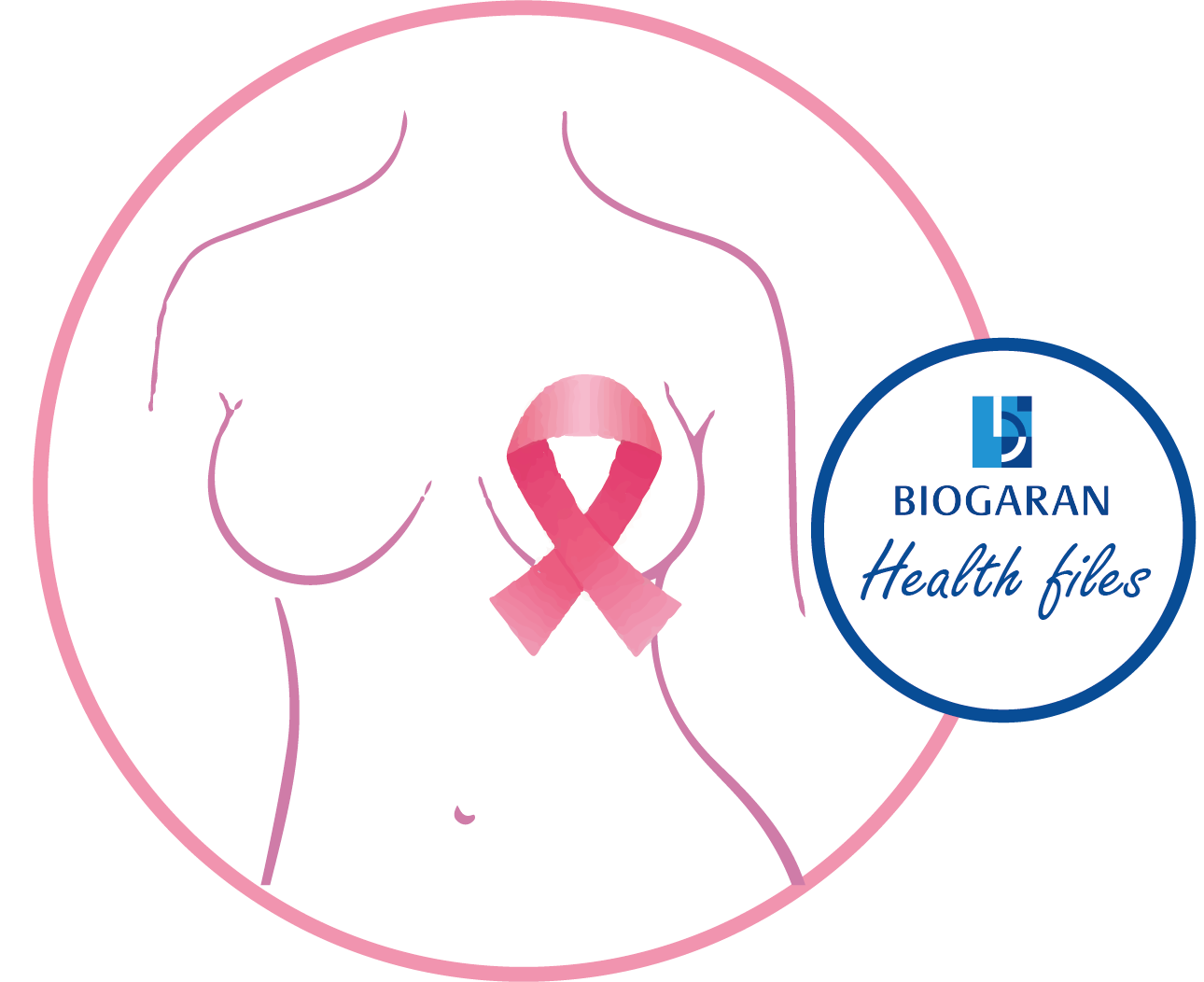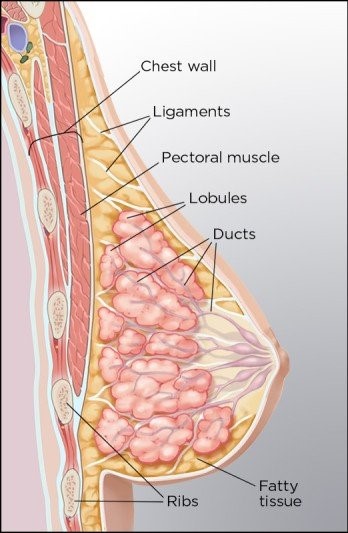Understanding and preventing breast cancer
A new health file to better understand breast cancer, its causes and its treatments

Posted on
I) Breast cancer : definitions and key figures
1 – Key figures and facts regarding breast cancer
- In 2020, breast cancer was the most common cancer in the world with 2.2 million cases [1].
- Breast cancer is the leading cause of cancer mortality in women, with 685,000 deaths from breast cancer in 2020 [1].
- The highest mortality rates from breast cancer are in Africa and Polynesia [1].
- In Africa, 50% of women who die of breast cancer are under 50 years of age [1].
- In 2020, 129,400 cases of breast cancer were reported in sub-Saharan Africa. According to the UN, the cancer burden is expected to double by 2040 in the region [2].
2 – Understanding breast anatomy

Image from Memorial Sloan Kettering Cancer Center
The breast is an organ composed of various elements [3]:
- The nipple, which represents the external part of the organ [3].
- The lobules, which are “little bags” located inside the breast that are responsible for producing milk during lactation [3,4].
- The milk ducts, which connect the lobules to the nipple and ensure the passage of milk to the nipple. [3,4].
- The skin, which envelops the whole [4].
The cells of the breast are sensitive to sex hormones (estrogen and progesterone, produced by the ovaries, adrenal glands and fat tissue) as well as to other hormones, such as prolactin secreted by the brain. The breasts are crossed by vessels and lymph nodes, which help to protect the body against infections [3].
The main forms of breast cancer and the evolution of the disease
Breast cancer refers to the appearance of abnormal cells in a breast. These cells can multiply rapidly to form a malignant tumor [4]. The term breast cancer can include more than a dozen different cancers [4]. However, in 95% of cases [3], cancer develops either:
- From the cells lining the ducts, we speak of ductal cancer (85% of cases) [1].
- From the cells of the lobules, in this case we speak of lobular cancer (15% of cases) [1].
A distinction is also made between so-called hormone-dependent or hormone-sensitive cancers, which are caused by the female sex hormones (estrogens) [4].
Breast cancers have different stages of development. In the first stage, the cancerous tumor remains in its duct of origin and does not cause any symptoms; this is called stage 0 or non-invasive (in situ) cancer [1]. In most cases, non-invasive cancers are ductal in nature [4]. However, this cancer can evolve and become infiltrating or invasive. In this case, it will invade the surrounding breast tissue and sometimes the rest of the body to form metastases [1]. The survival prognosis of invasive breast cancer is poorer than that of non-invasive breast cancer [1].
II) What are the risk factors for breast cancer ?
Although it is difficult to specifically identify the causes of breast cancer, its occurrence can be the result of non-modifiable or behavioral risk factors.
1 – Non-modifiable risk factors
Breast cancer can result from several non-modifiable factors:
- Age and gender: these are the main risk factors for breast cancer [3]. Indeed, 99% of breast cancer cases are in women and more than 80% of cases develop after the age of 50 [3].
- Family history: The risk of developing breast cancer increases for women who have first-degree relatives (mother, sister, daughter) who already had breast cancer, especially before menopause [3].
- Personal predisposition: If a woman has had breast cancer, she is 3 to 4 times more likely to develop breast cancer than those who have never had breast cancer [5]. For patients with non-invasive ductal breast cancer, for example, the likelihood of developing invasive breast cancer is increased by 8 to 10 times [5].
- High exposure to estrogen: Some women had long exposure to estrogen, which is a risk factor for hormone-dependent cancers. These include women who had their first menstrual period before the age of 12, women who have no children or late pregnancies, and postmenopausal women after the age of 50 [5].
2 – Behavorial or lifestyle factors
Some lifestyle habits may favor the occurrence of breast cancer:
- Overweight and obesity [5].
- Smoking [5].
- Alcohol abuse [5].
- Sedentary lifestyle [5].
- Hormone replacement therapy for menopause when administered continuously for more than 5 years [5].
- Taking the contraceptive pill continuously for more than 4 years [5].
Maintaining a healthy lifestyle by decreasing these habits in your daily life will help you combat the behavioral risk factors.
III) What are the symptoms of breast cancer ?
Generally, breast cancer is manifested by the appearance of several symptoms that should alert the patient:
- Appearance of a lump or thickening in the breast [1].
- Change in the appearance of the breast (size, shape, etc.) [1].
- Appearance of redness or orange peel [1].
- Modification of the nipple or the areola (skin surrounding it) [1].
- Abnormal discharge from the nipples [1].
- Nodes in the armpit [6].
- Localized breast pain [6]
It is imperative that you see your doctor promptly if you experience any of these symptoms.
IV) How is breast cancer diagnosed and treated ?
1 – The diagnosis
The diagnosis of breast cancer is made in several steps. First, the physician interviews the patient to learn about her history and various risk factors. The physician then performs a clinical breast examination by palpation to identify the presence of lymph nodes [7]. The physician then performs the following radiological examinations:
- Mammography of both breasts [7].
- An ultrasound of the breast [7].
- MRI in some cases [7].
When the doctor notices suspicious lesions, a breast biopsy may be performed to determine if a cell is cancerous or not [7]. The biopsy involves taking a sample through the skin (percutaneous biopsy) at the site of the lesion and then studying the sample [7]. The biopsy is used to determine whether the lesion is cancerous and to obtain details about the type, evolution and characteristics of the cancer so that appropriate treatment can be initiated [7]. The detection stage is very important because early detection of the disease increases the chances of survival to 90% [1].
2 – The treatment
Based on the information gathered at diagnosis, the patient should be given an appropriate treatment, considering the characteristics of her cancer and her preferences [8]. Cancer treatment requires multidisciplinary skills and involves at least 3 specialists: a surgeon, an oncologist and a radiotherapist [8].
The different treatments for breast cancer are:
Surgical treatment
The combination of surgery with other therapeutic methods is generally the most common option for treating breast cancer [8]. Depending on the stage of the cancer, the surgeon may either:
- Perform a lumpectomy or partial mastectomy to remove the tumor while retaining the breast [1].
- Perform a total mastectomy, which is the complete removal of the breast [1].
In some cases, the surgeon may have to remove lymph nodes from the patient’s breast.
Radiation therapy
In addition to surgical treatment, radiation therapy is often used to destroy cancer cells using x-rays [8]. This technique protects women with early breast cancer from mastectomy and reduces the risk of recurrence for those at a more advanced stage [1]. Radiation therapy should be performed on a regular schedule, on average 1 session per day, 5 days per week, for 3 to 6 weeks [8].
Drug treatment
There are 3 types of drug treatments for breast cancer:
- Hormone therapy: This treatment is generally recommended for patients with hormone-dependent breast cancer and aims at neutralizing the effect of estrogen to prevent the growth of cancer cells [8].
- Chemotherapy: This is usually given by injection or by mouth. It can be given before surgery and radiation therapy to shrink the tumor or after surgery to prevent cancer cells from growing in the body [8].
- Targeted therapy: This treatment directly targets the molecules responsible for the development of cancer in order to slow the progression of the disease. Targeted therapy is used in addition to chemotherapy. [8].
SOURCES :
[1] Breast Cancer – WHO – Available at: Breast Cancer (who.int)
[2] Sub-Saharan Africa: Cancer burden expected to almost double in next 20 years – UN – Available at: UN Info (un.org) Sub-Saharan Africa: cancer burden expected to almost double in next 20 years | UN Info (un.org)
[3] Understanding Breast Cancer – Ameli- Available at Understanding breast cancer | ameli.fr | Insured
[4] BREAST CANCER- VIDAL- Available on : Breast cancer – symptoms, causes, treatments and prevention – VIDAL
[5] RISK FACTORS FOR BREAST CANCER – VIDAL – Available on : Risk factors for breast cancer – VIDAL
[6] Symptoms and diagnosis of breast cancer – Ameli – Available on : The diagnosis of breast cancer | ameli.fr | Insured
[7] The symptoms and diagnosis of breast cancer – Ameli – Available on : The diagnosis of breast cancer | www.ameli.fr | Assuré
[8] Breast cancer treatment – Ameli – Available on : Breast Cancer Treatment | ameli.fr | Assuré
POI 0721-09/22
